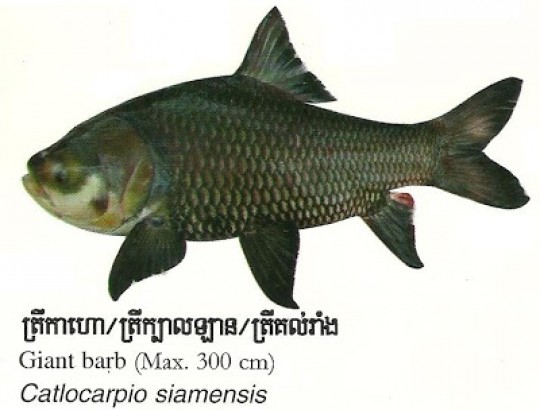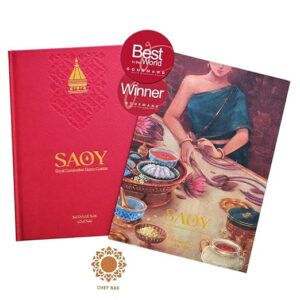Giant barb or Trei Kol Raing is the largest species of cyprinid in the world. These migratory fish are found only in the Mae Klong, Mekong, and Chao Phraya river basins in Indochina peninsular. It has declined drastically due to habitat loss and overfishing, and it is now considered critically endangered. Giant Barb is defined as the national fish of Cambodia. Giant barb is a freshwater fish. It was called in Khmer Trei Kol Raing or Trei Ka Hourn, or Trei Kbal Larn, and it is called in the scientific name “Catlocarpio Siamensis” and the English name “Giant Barb”.
What is Cambodia’s National Fish? Understating to the Nature of Trei Kol Raing
Trei Kol Raing’s Size

The Giant Mekong Barb is defined as the national fish of Cambodia. It is a freshwater fish. It was called in Khmer as Trei Kol Raing or Trei Ka Hourn, or Trei Kbal Larn, and it is called in scientific name “Catlocarpio siamensis” and English name “Giant Barb”. Comparing to other local fish, it is largest fish in Cambodia and probably the largest fish in the world. It weighs from 150 to 300 Kilograms and is about two to three meters long. It has large scales covering the entire body. Except the head and fins. The overall color of the body is seen as a separate color, where the above the stripe line is transparent black color and below the stripe line is silver color.
Trei Kol Raing’s Population and Conservation
This species lives along the Mekong River, especially the most appearance in the Tonle Sap Lake (the Great Lake). They are usually seen in the big pools along the edges of large rivers, but will seasonally enter smaller canals, floodplains and flooded forests. Young barbs are usually found in smaller tributaries and swamps, but can acclimatize to living in ponds, canals, and swamps. The fish generally live in pairs. These are migratory fish, swimming to favorable areas for feeding and breeding in different parts of the year. These slow-moving fish subsist on angle, phytoplankton and fruits of inundated terrestrial plants, rarely (if ever) feeding on active animals. In the lower Mekong basin, young giant barbs have been reported as occurring primarily in October.
Beside of easy to feed than any other fish, it is also rare fish and is also taken care of and preserved by the Royal Government as well as NGOs. Currently, it has been encouraged to breeding stations to try to breed this fish and to promote farmers to feed them because these fishes are easy to feed and fast growing. At the same time, there are have been fish-protecting areas along the Mekong River to preserve this endangered species. It is a highly efficient fish of economic and NGOs are interested in helping to maintain this type of fish in order not to be threatened and destroyed. The main threats are from habitat loss (For example, pollution and dams) and overfishing. The sharp population decline is well illustrated by catch data from Cambodia, where 200 tons of giant barbs were caught in 1964. By 1980, only about 50 fish were caught and by 2000, only 10. It was formerly an important fish in local catches below the Khone Phapheng Falls, but surveys between 1993 and 1999 only located a single small individual. Consequently, the giant barb is listed as Critically Endangered on the IUCN Red List. It has been entirely extirpated from the Chao Phraya River. In Cambodian, this type of fish is protected by Article 18, Chapter 2 of the Royal Decree 33 on the Management of Fisheries sector. Moreover, the Department of Fisheries has encouraged hatcheries and breeding stations to conduct research and experimentation on breeding and incubation in order to stock the fish in natural water bodies and use for aquaculture. Since 2000, the Department of Fisheries has cooperated with the Project for the Management of the Freshwater Capture fisheries of Cambodia of the Mekong River Commission to tag and release into the wild barbs captured in bag-net fisheries in the Tonle Sap River, in order to study its migration and growth.
Why Trei Kol Raing is The National Fish in Cambodia?
Being a largest fresh water fish in Cambodia, Fish meat is delicious and rich in protein, which is good for health and can make blood vessels function smoothly. It is very gentle and does not chase other fishes as food. Their meat is delicious which makes Cambodian like to eat. In ancient times the barb was carved on the wall of temples at Angkor Wat. Furthermore, its scales are popularly used for making a type of shuttlecock (popular instrument used in a game in which a group stand in a circle and kick the shuttlecock from person to person) for a Khmer popular sport.
The Trei Kol Raing have been fascinated and cared for since the 1960s. The organization, which has a role in the research and conservation of this species, is the Ministry of Agriculture, Forestry and Fisheries. The Trei Kol Raing is regarded as symbol of the Kingdom of Cambodia by the Royal Decrees NS/RKT/0305/149 dated 21st March 2005, as National Fish. This designation brings conservation awareness to this species.




